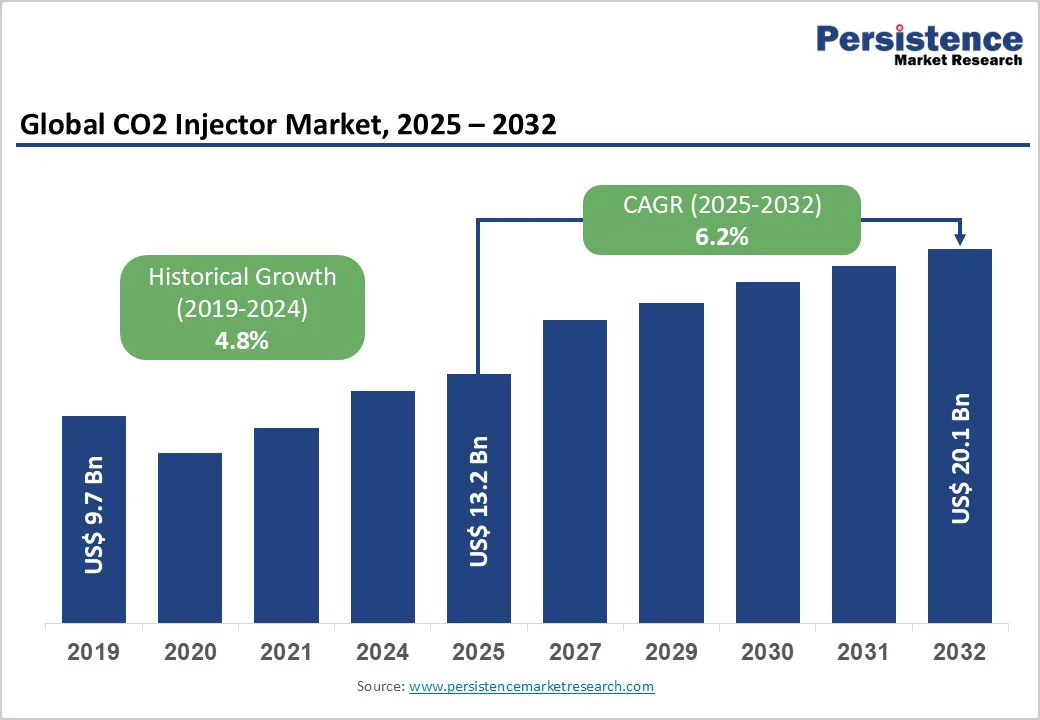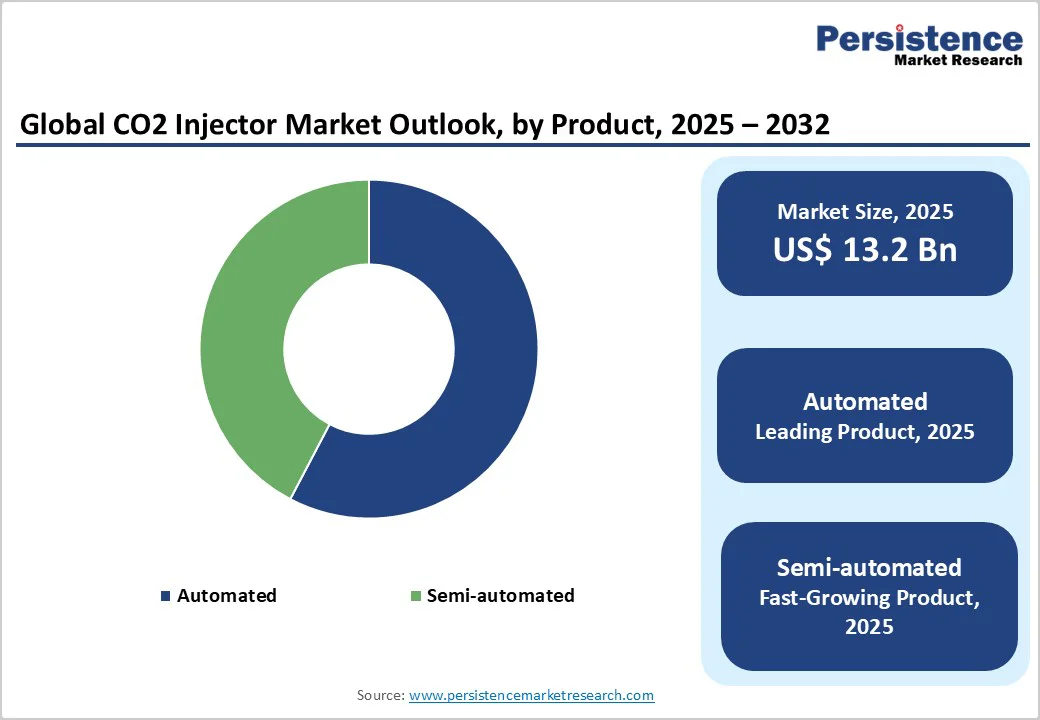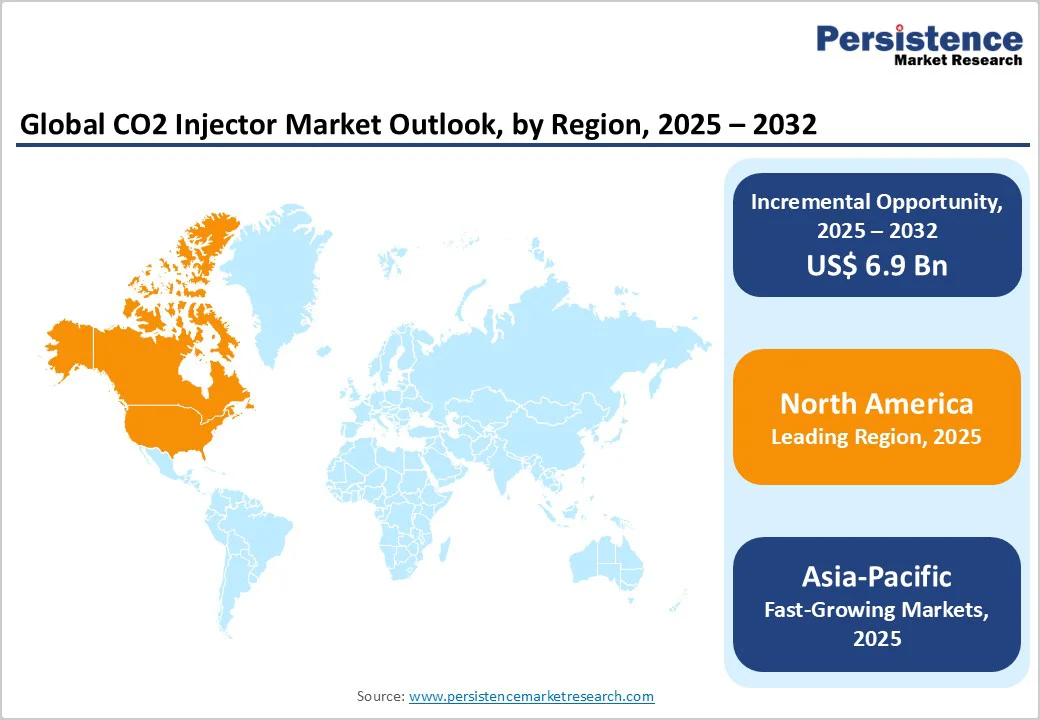ID: PMRREP33946| 183 Pages | 25 Nov 2025 | Format: PDF, Excel, PPT* | Healthcare

The global CO2 injector market is valued at US$13.2 billion in 2025 and projected to reach US$20.1 billion at a CAGR of 6.2% during the forecast period from 2025 to 2032.
The CO2 injector industry encompasses the manufacturing and distribution of carbon dioxide (CO2) injection systems, which are used in a variety of applications, including carbonation of beverages, enhanced hydrocarbon recovery, and reduction of greenhouse gas emissions. Critical to their function as injectors, which deliver regulated quantities of CO2 into specific environments, these injectors promote sustainability and efficiency across a variety of industries.
| Key Insights | Details |
|---|---|
| Global CO2 Injector Market Size (2025E) | US$13.2 Bn |
| Market Value Forecast (2032F) | US$20.1 Bn |
| Projected Growth (CAGR 2025 to 2032) | 6.2% |
| Historical Market Growth (CAGR 2019 to 2024) | 4.8% |

Sustainability-driven agricultural practices are the primary driver of the global CO2 injector market. In light of the worldwide challenge of sustaining an expanding population, an increasing number of nations recognize the critical importance of regulated carbon dioxide injection to maximize agricultural yields and safeguard food security.
Carbon dioxide is a fundamental constituent of photosynthesis, an organismal process by which plants convert light energy into chemical energy, thereby promoting their growth and development. The strategic implementation of carbon dioxide (CO2) injections in controlled environments, such as conservatories, can augment photosynthetic rates and thereby elevate crop productivity.
An increasing number of governments and agricultural stakeholders worldwide are recognizing the advantages that precision agriculture can derive from CO2 injection. The implementation of carbon dioxide regulation enables agricultural practitioners to create an ideal environment conducive to plant growth, regardless of the weather conditions outside.
This is especially critical in areas characterized by severe weather conditions, seasonal fluctuations, or scarcity of cultivable land. With the assistance of CO2 injectors, producers consistently and significantly increase CO2 levels, ensuring that plants have sufficient CO2 for photosynthesis even at suboptimal ambient concentrations.
The ability to establish a regulated microclimate is a factor in increased agricultural productivity, enhanced product quality, and expedited growth cycles. Furthermore, the convergence of sustainable farm practices with worldwide endeavours to diminish the environmental impact of agriculture is evident. Farmers can prevent deforestation and safeguard biodiversity by increasing crop yields without expanding agricultural land by implementing CO2 injection systems.
One significant obstacle the global CO2 injector market faces is the lack of standardized guidelines for carbon capture and utilization (CCU) technologies and the complexity of regulatory frameworks. Diverse regulations and standards are emerging as governments around the world intensify efforts to combat climate change, creating a complex environment for organizations seeking to implement CO2 injection solutions.
Industries aiming to implement these technologies face challenges in their decision-making processes due to the lack of a unified, globally accepted framework. They must thus navigate through a multitude of regulatory requirements, compliance standards, and reporting protocols.
Market participants face significant challenges due to the absence of standardized guidelines, particularly regarding the integration of technology, operational protocols, and the quantification of carbon credits.
Organizations that invest in CO2 injectors face the challenge of understanding and complying with a range of regulations. This can result in setbacks, increased compliance-related expenses, and uncertainties about the sustained feasibility of their investments.
As a key strategy in the fight against climate change, the growing emphasis on carbon capture and utilization (CCU) technologies is a significant driver of the global CO2 injector market. CO2 injectors are of utmost importance to the growing international effort to mitigate greenhouse gas emissions.
They accomplish this by capturing and repurposing carbon dioxide emitted by power plants, industrial processes, and other sources. Environmental organizations, governments, and industries are beginning to recognize the potential of CO2 injectors to establish a sustainable business model and reduce environmental impact.
By capturing and utilizing carbon dioxide in a controlled manner, these technologies prevent its emission into the atmosphere, where it would otherwise contribute to global warming.
CO2 injectors support a circular economy by repurposing captured CO2 for applications such as enhanced oil recovery, greenhouse food production, and manufacturing. This process not only mitigates emissions but also converts carbon dioxide into a valuable resource.
In light of industries' pursuit of inventive approaches to fulfil sustainability objectives, the CO2 injector market is poised to gain from the need for technologies that promote environmental stewardship and carbon neutrality.
Furthermore, the growing prevalence of CO2 injectors can be attributed to opportunistic drivers, including the possibility of obtaining carbon credits and financial incentives. Regulatory bodies and governments are implementing incentive programs to encourage companies to adopt carbon capture and utilization technologies.
Magnetic resonance-guided systems dominate the market with a 57.7% share in 2025, as they provide precise, consistent, and programmable gas delivery, which is essential for safe angiographic and interventional imaging procedures. Manual injection often risks variable pressure and inconsistent flow, leading to discomfort or suboptimal imaging.
According to a 2021 study in Medicine (LWW), automated systems achieved excellent safety, with no major adverse events and patient pain scores averaging 3.5 on the VAS scale, indicating strong tolerability.
Moreover, hospitals use around 3 m³ of medical-grade CO2 per bed annually (source: MDPI, Sustainability Journal), emphasizing the need for efficient, automated control systems to manage volume and precision. Their integration with digital interfaces, reduced human error, and compliance with modern hospital protocols drive their global preference.
Interventional Radiology dominates the CO2 injector market because it offers the safest and most effective use of CO2 as an alternative to iodinated contrast, particularly in patients with renal impairment. Clinical studies published by the Society of Interventional Radiology (SIR) report that CO2 angiography reduces iodinated contrast use by nearly 50% (32 mL vs 65 mL) and lowers acute kidney injury rates from 4.8% to 3.9%.
A PubMed Central (PMC) review found a 97.9% technical success rate for renal and iliofemoral interventions using CO2-guided imaging, confirming its reliability. These outcomes, combined with CO2’s non-toxic, non-allergenic nature and suitability for peripheral and abdominal interventions, make interventional radiology the largest and most clinically driven application for CO2 injector systems worldwide.

North America is positioned to hold the largest proportion of the global market. Multiple factors collectively contribute to the region's preeminence across diverse industries. To begin with, North America, specifically the U.S. and Canada, is distinguished by its highly developed technological infrastructure and strong healthcare system.
This promotes the widespread adoption of state-of-the-art technologies across sectors such as manufacturing, healthcare, and information technology. Additionally, substantial research and development is conducted in the region, which promotes innovation and stimulates market expansion.
North America's leadership position is bolstered by its attention to technological advancements, the presence of key industry actors, and its research institutions. Furthermore, the region's robust regulatory frameworks and established standards foster a favorable environment for business growth and success.
Due to the high demand for sophisticated solutions in industries such as manufacturing, information technology, and healthcare, North America holds the largest market share among global markets.
The global market is anticipated to expand at the quickest rate in South Asia and the Pacific. This forecast is supported by several factors that, when combined, foster a conducive environment for emerging sectors.
The expansion of the consumer market is driven by factors such as rapid urbanization, population growth, and rising disposable incomes in countries like India, China, and Southeast Asia. Consequently, enterprises operating in diverse industries such as technology, manufacturing, and healthcare are augmenting their market share in the area to access the burgeoning clientele.
Additionally, substantial progress is being made in adopting new technologies and advancing digital transformation across South Asia and the Pacific, driving market expansion. Moreover, the region's burgeoning start-up ecosystem, emphasis on infrastructure development, and smart city initiatives all contribute to its rapid economic expansion.
The expansion of the middle class and the maturation of industries are expected to drive a significant surge in demand for innovative products and solutions across sectors. Consequently, South Asia and the Pacific are projected to have the highest growth rate among global markets.
Europe plays a critical role in the CO2 injector market thanks to a high prevalence of vascular and cardiovascular disease, combined with substantial medical technology investment and infrastructure. In the World Health Organization European Region, cardiovascular diseases (CVDs) account for more than 42.5% of all deaths, equating to around 4.2 million deaths annually.
Meanwhile, in the European Union, circulatory diseases accounted for 32.7% of all deaths in 2022. On the investment side, medical technology expenditure in Europe stood at about €319 per capita in 2024, accounting for roughly 7.7% of total healthcare spending.
These facts underscore a high disease burden, established clinical systems for imaging and interventional devices, and significant spending power, making Europe a key region for CO2 injector adoption in vascular and angiographic applications.

Leading players in the global CO2 injector market, including Angiodroid, Malek Medical GmbH, Optimed Corp., are strengthening their dominance through major R&D investments aimed at improving efficiency and precision.
They are expanding into emerging markets to meet rising demand for sustainable solutions and to adapt products to local standards. Additionally, their strong focus on sustainability and CSR initiatives enhances brand reputation and aligns with global priorities for eco-friendly, energy-efficient technologies, supporting long-term market leadership and growth.
The global CO2 injector market is projected to be valued at US$ 13.2 Bn in 2025.
Rising angiographic procedures, renal-safe contrast alternatives, automation in imaging, and growing adoption of minimally invasive vascular interventions drive growth.
The global CO2 injector market is poised to witness a CAGR of 6.2% between 2025 and 2032.
Expanding healthcare infrastructure, rising demand in emerging economies, technological automation, and increased clinical adoption for renal-safe imaging offer opportunities.
Angiodroid, Malek Medical GmbH, Optimed Corp.
| Report Attribute | Details |
|---|---|
| Historical Data/Actuals | 2019 - 2024 |
| Forecast Period | 2025 - 2032 |
| Market Analysis | Value: US$ Bn; Volume: Units |
| Geographical Coverage |
|
| Segmental Coverage |
|
| Competitive Analysis |
|
| Report Highlights |
|
By Product
By Application
By End-user
By Region
Delivery Timelines
For more information on this report and its delivery timelines please get in touch with our sales team.
About Author